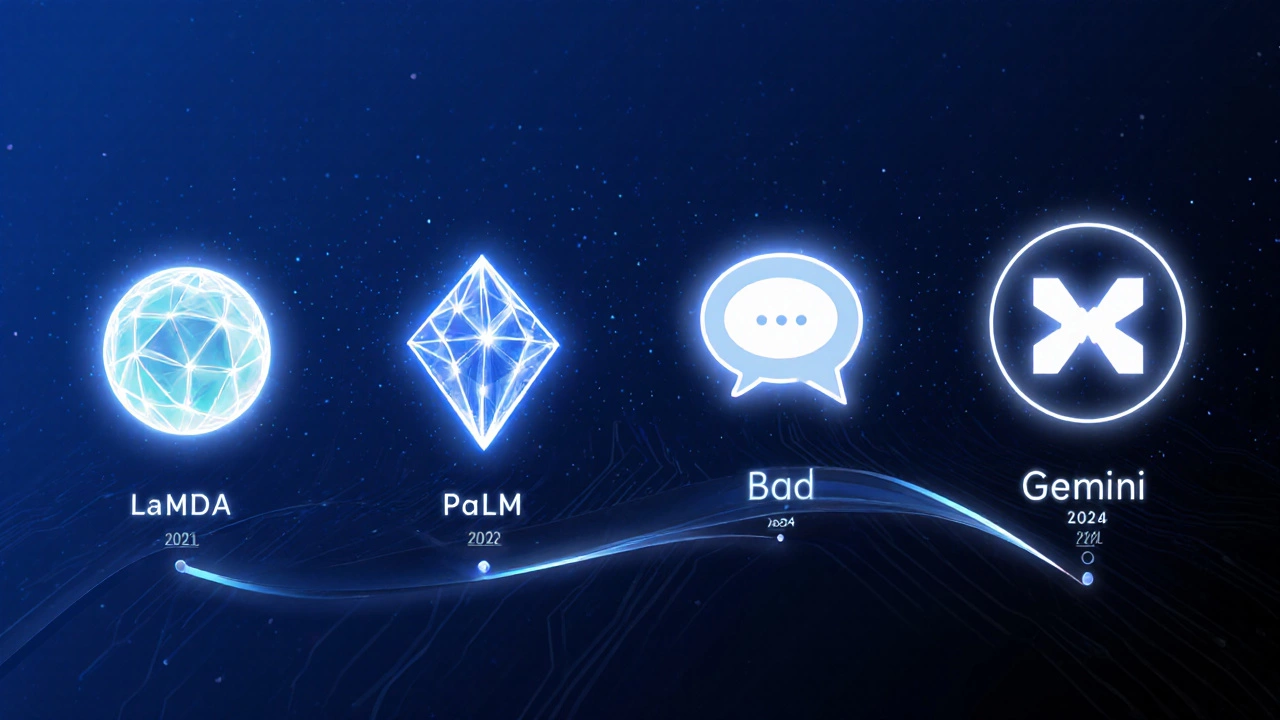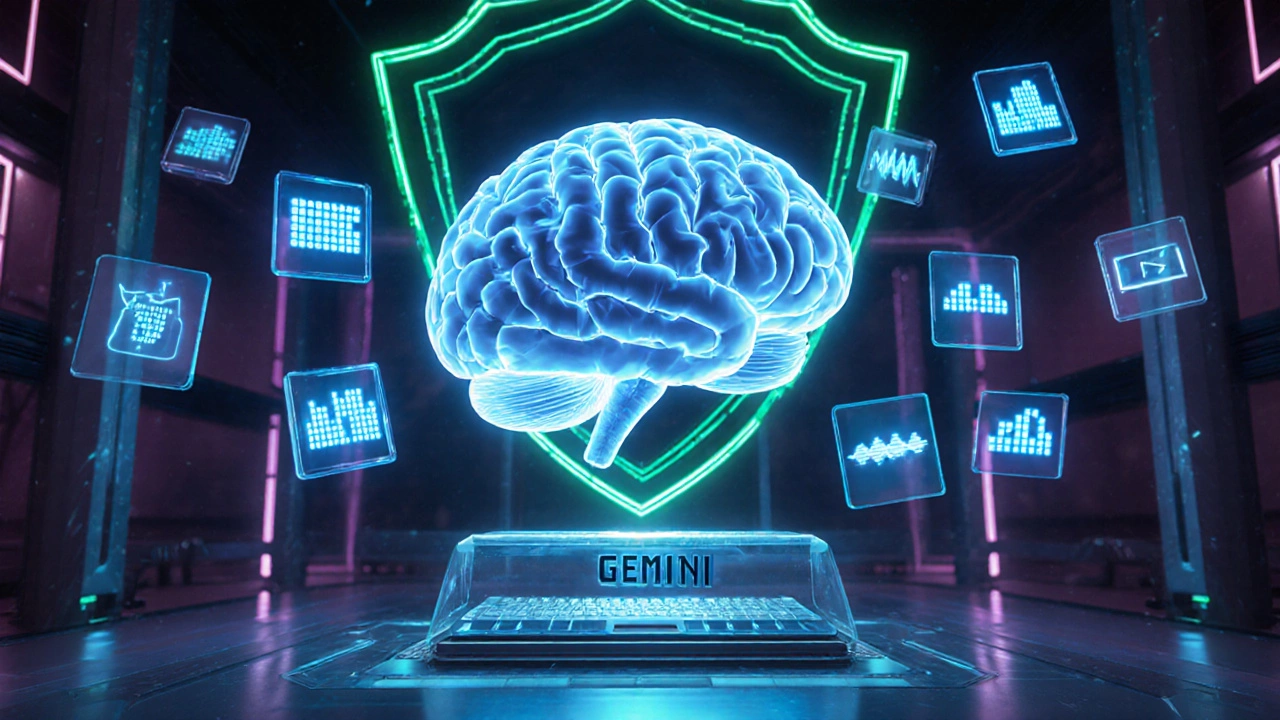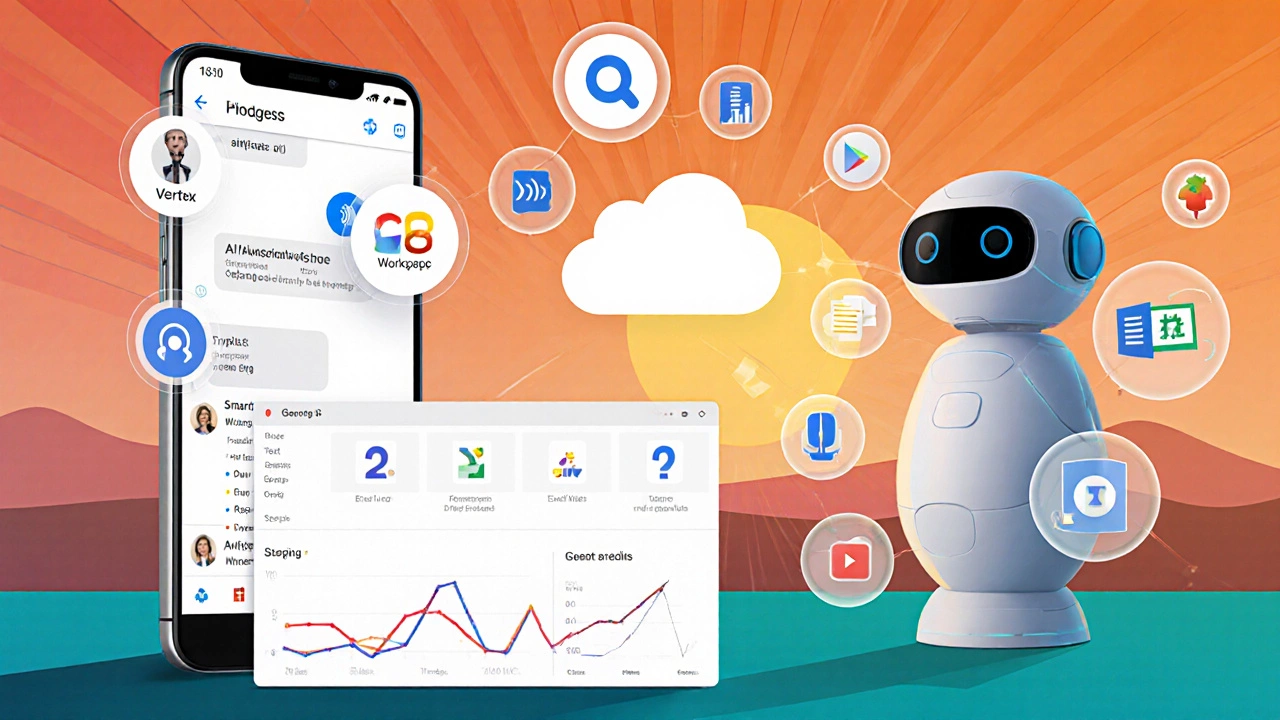What is Google's AI Called? - Meet Gemini, Bard, and More
 Oct, 10 2025
Oct, 10 2025
Google AI Name Explorer
This tool helps you understand how Google's AI naming has evolved from LaMDA to Bard to Gemini. Explore the different components and their relationships.
LaMDA
Language Model for Dialogue Applications
Released 2021
Bard
Google's Conversational AI
Released 2023
Gemini
Multimodal AI Family
Released 2024
AI Evolution Timeline
LaMDA (2021)
First public language model for dialogue
Bard (2023)
Consumer-facing chatbot using LaMDA
Gemini (2024)
Unified multimodal AI platform
Feature Comparison
| Feature | LaMDA | Bard | Gemini |
|---|---|---|---|
| Release Year | 2021 | 2023 | 2024 |
| Model Type | Text-only LLM | Text-based chat | Multimodal LLM |
| Input Types | Text only | Text + images | Text, Image, Audio, Video |
| Audience | Research | Consumers | Developers & Enterprises |
Interactive Quiz
Which of these statements about Google's AI is TRUE?
When you hear “Google’s AI,” most people think of Google Gemini, a family of large language models that power the company’s latest conversational products. But the story behind that name stretches back over a decade, spanning research projects, re‑branding moves, and a growing ecosystem of tools. This guide breaks down the evolution, the current lineup, and where Google is pointing next.
From LaMDA to Gemini - The Naming Journey
The first public glimpse of Google’s language‑model ambitions arrived in 2021 with LaMDA (Language Model for Dialogue Applications). LaMDA was built to handle open‑ended conversation, but it never became a consumer‑facing brand. In parallel, the internal research team unveiled PaLM (Pathways Language Model), a massive transformer that set new benchmarks on reasoning tasks.
By 2023 Google consolidated its conversational offerings under the name Bard. Bard used LaMDA as its brain and was positioned as a direct answer to ChatGPT. However, Bard remained a single product rather than a family of models.
In early 2024 the company announced Gemini, a brand that unifies LaMDA, PaLM, and newer multimodal research. Gemini models come in several sizes (Gemini 1.0, 1.5, 2.0) and can process text, images, audio, and video, marking a clear shift from pure‑text LLMs to true multimodal AI.
Core Components of Google Gemini
- Architecture: Gemini builds on the Pathways system, allowing a single model to handle many tasks without task‑specific fine‑tuning.
- Multimodal Tokens: Images are broken into visual tokens that sit alongside text tokens, enabling seamless cross‑modal reasoning.
- Safety Guardrails: Real‑time feedback loops and human‑in‑the‑loop evaluation keep outputs aligned with Google’s Responsible AI principles.
The result is a model that can draft an email, caption a photo, summarize a video, and even generate code snippets-all from one unified engine.
How Google Deploys Gemini
Google embeds Gemini into three main product families:
- Bard: The consumer chat app that now runs on Gemini‑1.5, offering richer answers and visual generation.
- Vertex AI: The cloud service where developers can fine‑tune Gemini for specific domains, from legal drafting to medical coding.
- Google Workspace: Features like “Smart Compose” in Gmail and “Generate Slides” in Slides are powered by Gemini’s contextual understanding.
Each deployment uses the same underlying model but adjusts latency, token limits, and safety thresholds to fit the use case.

Comparison: Gemini vs. Bard vs. LaMDA
| Aspect | Gemini | Bard | LaMDA |
|---|---|---|---|
| Release year | 2024 | 2023 | 2021 |
| Core model | Pathways‑based multimodal LLM | Gemini‑1.5 (behind the scenes) | LaMDA 2.0 |
| Input types | Text, image, audio, video | Text + optional images | Text only |
| Primary audience | Developers & enterprises | Consumers | Research community |
| Safety controls | Real‑time guardrails, RLHF | Layered moderation, user feedback | Initial safety layers |
The table shows that Gemini isn’t a separate chatbot; it’s the engine that powers Bard and other services. LaMDA remains a research milestone, while Gemini brings the next generation of multimodal capability.
Related Google AI Projects
Beyond the headline brands, Google runs several complementary initiatives:
- DeepMind: The sister AI lab that contributed Transformer‑based breakthroughs used in Gemini.
- TensorFlow: The open‑source framework many Gemini models are trained on before being exported to Google’s TPU fleet.
- Vertex AI: Cloud‑native platform where businesses can run, fine‑tune, and monitor Gemini models.
- Google Cloud AI Hub: Marketplace for pre‑built AI solutions built on Gemini.
All these pieces interlock, forming a robust ecosystem that lets developers focus on applications rather than model training from scratch.
Future Roadmap - What’s Next for Google’s AI?
Google’s public roadmap hints at two major directions:
- Gemini 3.0 and beyond: Expected to push token limits past 1million, enabling whole‑document analysis and longer code generation.
- Real‑time multimodal interaction: Voice‑activated agents that can see, hear, and respond instantly, powered by on‑device inference for privacy.
In parallel, Google is strengthening its Responsible AI framework, adding explainability dashboards and stronger user‑controlled data settings.

Common Misconceptions
- “Google’s AI is just Bard.” - Wrong. Bard is a product that runs on Gemini; the underlying model is a broader platform.
- “Gemini will replace all Google services overnight.” - Not true. Integration happens gradually, with pilot phases in Workspace and Cloud.
- “Google does not have an open‑source AI model.” - While Gemini itself stays proprietary, Google releases research papers and tools like TensorFlow that let the community experiment with similar architectures.
Getting Started with Gemini on Vertex AI
- Sign in to the Google Cloud Console.
- Navigate to Vertex AI→Models and click “Create Model”.
- Select “Gemini” from the list of pre‑trained models.
- Choose the desired size (e.g., Gemini‑1.5‑Base) and configure region, CPU/GPU allocation.
- Deploy the model to an endpoint, then test via the integrated playground or via API calls.
Google provides a free tier that includes 100k token quota per month, enough for prototyping small chatbots or text‑summarizers.
Frequently Asked Questions
What does “Gemini” stand for?
Google chose the name “Gemini” to signal a dual‑nature capability: handling both text and other media (image, audio, video) in a single model, much like the twin stars of the Gemini constellation.
Is Gemini the same as Bard?
No. Bard is a consumer chat interface that currently runs on Gemini‑1.5. Gemini is the underlying family of large language models, while Bard is just one of many products built on top of it.
Can developers fine‑tune Gemini?
Yes. Through Vertex AI, users can upload domain‑specific datasets and run supervised fine‑tuning on selected Gemini variants, enabling custom vocabularies, tone, or safety constraints.
Does Gemini support real‑time image generation?
The current Gemini 2.0 series includes a diffusion‑based image‑generation module. Users can request images via the API, but generation time depends on model size and hardware.
How does Google ensure Gemini’s outputs are safe?
Google combines Reinforcement Learning from Human Feedback (RLHF), real‑time moderation filters, and a layered “Safety Guardrail” system that blocks disallowed content before it reaches the user.